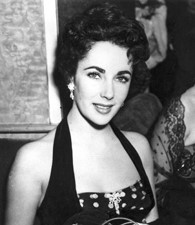Elizabeth Taylor spent her life on camera. She took her first screen test in 1939 at age seven and worked as an actress until 2003, winning two Academy Awards. Taylor grabbed attention for dramas onscreen and off, fascinating the public with her turbulent love life and erratic health. Unlike contemporary 15-minute celebrities, Taylor’s stardom truly endured.
Early Days
Elizabeth Rosemond Taylor was born on February 27, 1932, in London to American parents. Taylor’s father was an art dealer from St. Louis and her mother had been a stage actress until starting a family.
In 1939, the Taylors moved to Los Angeles to avoid the onset of World War II. Shortly thereafter, a family friend took note of Taylor’s striking beauty and suggested that the young girl take a screen test, which launched her acting career.
Universal Pictures signed Taylor for a yearlong contract and at age 10, she debuted in “There’s One Born Every Minute” (1942). Taylor signed with MGM after Universal failed to renew her contract; her father’s friendship with a producer at the studio helped secure her future. A year later, Taylor appeared in “Lassie Come Home.”
Sources in this Story
- Turner Classic Movies Movie Database: Biography for Elizabeth Taylor
- IMDb: Elizabeth Taylor
- CNN: Larry King: Elizabeth Taylor: Loving men and being a ‘dame’
- Elizabeth Taylor AIDS Foundation
- The New York Times: Elizabeth Taylor: 1932-2011
Notable Accomplishments
Taylor’s breakthrough came in 1944 with the film “National Velvet.” The film grossed more than $4 million and made Taylor MGM’s biggest child star.
During the late 1940s, Taylor made a series of films, though none were as successful as “National Velvet.” In 1951 she was given an opportunity at a meatier role, playing Angela Vickers in “A Place in the Sun.” The part helped establish Taylor as a serious actress, but a string of mediocre pictures followed.
In 1956, Taylor made another big film, “Giant,” which costarred Rock Hudson (a longtime friend) and James Dean. In the meantime, Taylor’s private life had taken center stage: by 1951, her first marriage to hotel heir Nicky Hilton ended, after only 10 months. Taylor then married Michael Wilding in 1952 and had two sons. Five years later, the couple split up and Taylor wed Mike Todd, a Hollywood producer, within days of the divorce.
Sadly, Todd died in a plane crash just after the birth of their daughter, Elizabeth Frances. Within a year, Taylor began a liaison with Todd’s best friend, entertainer Eddie Fisher, breaking up his marriage to actress Debbie Reynolds.
In 1961, Taylor won her first Best Actress Oscar for her performance in “Butterfield 8”; many speculate that it was awarded out of pity: Taylor had nearly died of pneumonia that year. Shirley MacLaine, who was nominated for “The Apartment,” reportedly exclaimed, “I lost to a tracheotomy!”
In 1963, Taylor’s professional and personal life climaxed with the film “Cleopatra.” Not only did she negotiate the first million-dollar contract for an actress, she also met her next husband, costar Richard Burton.
According to director Joseph Mankiewicz, working with the pair was like “being locked in a cage with two tigers.” By 1964, Burton and Taylor had divorced their respective spouses and married one another. The pair made nine films together, including “Who’s Afraid of Virginia Woolf?” (1966), which earned Taylor her second Oscar.
The Woman and Her Work
- “The Elizabeth Taylor Signature Collection (National Velvet/Father of the Bride/Cat on a Hot Tin Roof/Butterfield 8)”
- “Who’s Afraid of Virginia Woolf?”
- “Suddenly, Last Summer”
- “Cleopatra”
- “Elizabeth: The Life of Elizabeth Taylor” by Alexander Walker
The Rest of the Story
Taylor retired as an actress in 2003. She was married three more times: once to Burton—again—after the pair divorced for a year in 1974; then to American politician John Warner and finally, construction worker Larry Fortensky, whom she met at an alcohol rehabilitation center. She divorced Fortensky in 1996.
In addition, Taylor was made a dame by the Queen of England. In a 2001 interview with Larry King, she said: “Well, I have been a broad all my life. (Laughter)…And dame just automatically came next.”
In 1985, Taylor lost one of her closest friends, actor Rock Hudson, to AIDS. The tragic experience, coupled with the belief that none of her contemporaries were really doing anything about the problem, prompted her to create the Elizabeth Taylor AIDS Foundation, a nonprofit that raises funds for AIDS organizations worldwide.
Taylor described the night before Hudson died to Larry King: “And we laughed about making chocolate martinis. And oh, he was just skin and bones. And I thought I am going to do everything in my living power to get at this disease and kill it by its throat.”
Taylor grabbed headlines with her frail health; she was hospitalized for a brain tumor, spinal surgery, hip replacements, respiratory problems and a number of other issues, including alcohol addiction. Taylor died of congestive heart failure on March 23, 2011.
This article was originally written by Isabel Cowles; it was updated January 10, 2017.











